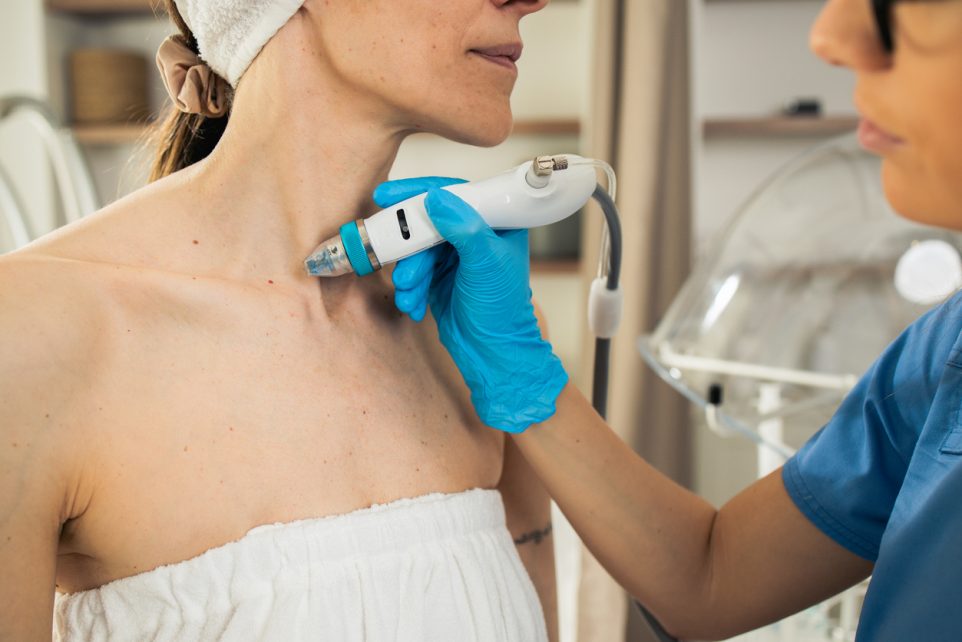Debunking 5 Myths Around Radio Frequency Skin Tightening

Middle-aged woman taking care of her skin health
Radiofrequency (RF) skin tightening is a non-surgical method that has been gaining traction in the aesthetics field due to its ability to rejuvenate skin by improving elasticity and firmness. This procedure utilizes RF energy to heat the deep layers of skin, stimulating the production of collagen, the protein essential for maintaining skin’s structural integrity. The concept of RF therapy has been around since 2001, with ongoing advancements enhancing its safety and effectiveness.
Myth 1: Radiofrequency Skin Tightening Is Completely Risk-Free
While RF skin tightening is generally safe, especially when performed by a certified practitioner, it is not without risks. Common side effects include temporary redness, swelling, and tingling. More severe complications, such as burns or changes in skin pigmentation, are rare but possible, especially if the procedure is not performed correctly. Therefore, it’s crucial to choose providers who are certified by reputable organizations like the American Board of Cosmetic Surgery.
Myth 2: RF Skin Tightening Can Replace Surgical Procedures
RF skin tightening provides noticeable improvements in skin laxity and is often presented as a non-surgical alternative to facelifts. However, it does not offer the same results as surgical procedures. RF therapy is best suited for those experiencing early signs of aging and looking for moderate improvements without the downtime associated with surgery.
Myth 3: Results Are Immediate and Permanent
Achieving optimal results with RF skin tightening requires multiple sessions, and the effects are gradually noticeable as collagen production increases. The results are not permanent; maintenance treatments are needed to preserve the skin tightening effects, emphasizing the necessity for a long-term commitment to the treatment regimen.
Myth 4: All RF Devices Are Equally Effective
The success of RF skin tightening largely depends on the technology used. There are various RF systems available, such as Thermalift, Exilis, Profound RF, Thermage, and Thermi, each varying in how they deliver RF energy and target different skin depths. It is essential to select a skilled provider who uses well-maintained, effective equipment tailored to your specific skin needs.
Myth 5: RF Skin Tightening Is Suitable for Everyone
RF skin tightening is versatile but not suitable for everyone. Individuals with certain medical conditions, those with active skin infections, autoimmune disorders, or implanted electronic devices, and pregnant women should avoid this treatment. An initial consultation with a healthcare provider can help determine if RF skin tightening is a safe option.
The Reality: Benefits and Considerations
RF skin tightening can effectively enhance skin texture and firmness, especially in those with mild to moderate skin laxity. It is particularly beneficial for fighting signs of aging like sagging skin and wrinkles. When performed by experienced professionals, RF therapy can offer significant improvements, making it a popular choice for those seeking non-invasive aesthetic treatments.
How RF Skin Tightening Works
RF skin tightening works by directing controlled RF energy to the skin, which heats the dermis between 122°F and 167°F. This thermal energy stimulates the body’s natural healing process, prompting the production of new collagen and elastin fibers, which are crucial for maintaining skin firmness and elasticity.
Benefits
The primary benefit of RF skin tightening is the improvement of skin texture and firmness, effectively reducing wrinkles and sagging. Additionally, it has shown promise in mitigating sun damage and enhancing facial contours through targeted treatments.
Potential Side Effects
Typical side effects are minor and temporary, including redness, swelling, and tingling. More serious complications, while rare, can occur if the procedure is not performed with precision.
How Much Does RF Skin Tightening Cost?
The cost of RF skin tightening varies based on geographic location, the area of the body treated, and the specific technology used. Prices generally range from $1,000 to $4,000 per session, with treatments often requiring multiple sessions for optimal results.